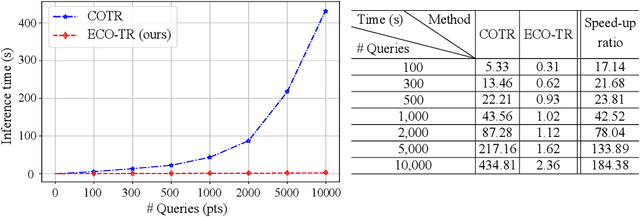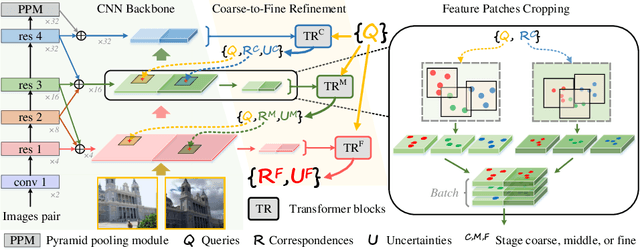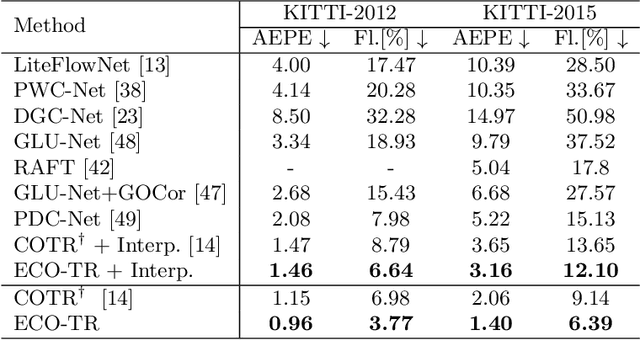Dongli Tan
MatchAnything: Universal Cross-Modality Image Matching with Large-Scale Pre-Training
Jan 13, 2025Abstract:Image matching, which aims to identify corresponding pixel locations between images, is crucial in a wide range of scientific disciplines, aiding in image registration, fusion, and analysis. In recent years, deep learning-based image matching algorithms have dramatically outperformed humans in rapidly and accurately finding large amounts of correspondences. However, when dealing with images captured under different imaging modalities that result in significant appearance changes, the performance of these algorithms often deteriorates due to the scarcity of annotated cross-modal training data. This limitation hinders applications in various fields that rely on multiple image modalities to obtain complementary information. To address this challenge, we propose a large-scale pre-training framework that utilizes synthetic cross-modal training signals, incorporating diverse data from various sources, to train models to recognize and match fundamental structures across images. This capability is transferable to real-world, unseen cross-modality image matching tasks. Our key finding is that the matching model trained with our framework achieves remarkable generalizability across more than eight unseen cross-modality registration tasks using the same network weight, substantially outperforming existing methods, whether designed for generalization or tailored for specific tasks. This advancement significantly enhances the applicability of image matching technologies across various scientific disciplines and paves the way for new applications in multi-modality human and artificial intelligence analysis and beyond.
Efficient LoFTR: Semi-Dense Local Feature Matching with Sparse-Like Speed
Mar 11, 2024



Abstract:We present a novel method for efficiently producing semi-dense matches across images. Previous detector-free matcher LoFTR has shown remarkable matching capability in handling large-viewpoint change and texture-poor scenarios but suffers from low efficiency. We revisit its design choices and derive multiple improvements for both efficiency and accuracy. One key observation is that performing the transformer over the entire feature map is redundant due to shared local information, therefore we propose an aggregated attention mechanism with adaptive token selection for efficiency. Furthermore, we find spatial variance exists in LoFTR's fine correlation module, which is adverse to matching accuracy. A novel two-stage correlation layer is proposed to achieve accurate subpixel correspondences for accuracy improvement. Our efficiency optimized model is $\sim 2.5\times$ faster than LoFTR which can even surpass state-of-the-art efficient sparse matching pipeline SuperPoint + LightGlue. Moreover, extensive experiments show that our method can achieve higher accuracy compared with competitive semi-dense matchers, with considerable efficiency benefits. This opens up exciting prospects for large-scale or latency-sensitive applications such as image retrieval and 3D reconstruction. Project page: https://zju3dv.github.io/efficientloftr.
ECO-TR: Efficient Correspondences Finding Via Coarse-to-Fine Refinement
Sep 25, 2022



Abstract:Modeling sparse and dense image matching within a unified functional correspondence model has recently attracted increasing research interest. However, existing efforts mainly focus on improving matching accuracy while ignoring its efficiency, which is crucial for realworld applications. In this paper, we propose an efficient structure named Efficient Correspondence Transformer (ECO-TR) by finding correspondences in a coarse-to-fine manner, which significantly improves the efficiency of functional correspondence model. To achieve this, multiple transformer blocks are stage-wisely connected to gradually refine the predicted coordinates upon a shared multi-scale feature extraction network. Given a pair of images and for arbitrary query coordinates, all the correspondences are predicted within a single feed-forward pass. We further propose an adaptive query-clustering strategy and an uncertainty-based outlier detection module to cooperate with the proposed framework for faster and better predictions. Experiments on various sparse and dense matching tasks demonstrate the superiority of our method in both efficiency and effectiveness against existing state-of-the-arts.
 Add to Chrome
Add to Chrome Add to Firefox
Add to Firefox Add to Edge
Add to Edge